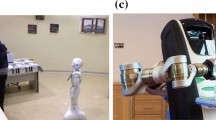Abstract
In order to consider robots as social partners rather than mere machines, they have to be perceived as living entities. In this paper we present a system to improve the robot’s liveliness based on the execution of non-repetitive, unpredictable, subtle actions that are running continuously during the operation of the robot. The so-called Liveliness System uses the existing interfaces, or communicative channels, and combines its actions with other systems working in the robot. The system has been successfully implemented in two social robots and the operation of the system has been showed during a competitive 2 player game played by a robot and a person.
Access this chapter
Tax calculation will be finalised at checkout
Purchases are for personal use only
Similar content being viewed by others
Notes
- 1.
Along the text, the terms liveliness and animacy will be used interchangeably.
- 2.
How different robot’s states or emotions are mapped to different values of the signal parameters is out of the scope of this paper and will require further studies.
References
Alonso-Martín, F., Castro-González, Á., Luengo, F., Salichs, M.: Augmented robotics dialog system for enhancing human-robot interaction. Sensors 15(7), 15799–15829 (2015). http://www.mdpi.com/1424-8220/15/7/15799
Bartneck, C., Kanda, T., Mubin, O., Al Mahmud, A.: Does the design of a robot influence its animacy and perceived intelligence? Int. J. Social Robot. 1(2), 195–204 (2009)
Bartneck, C., Kulić, D., Croft, E., Zoghbi, S.: Measurement instruments for the anthropomorphism, animacy, likeability, perceived intelligence, and perceived safety of robots. Int. J. Social Robot. 1(1), 71–81 (2009)
Castro-González, Á., Admoni, H., Scassellati, B.: Effects of form and motion on judgments of social robots’ animacy, likability, trustworthiness and unpleasantness. Int. J. Hum. Comput. Stud. 90, 27–38 (2016)
González-Pacheco, V., Castro-González, Á., Castillo, J.C., Malfaz, M., Salichs, M.A.: A design of child-robot interaction in hospitals. In: New Friends 2016: The 2nd International Conference on Social Robots in Therapy and Education, Barcelona, Spain, pp. 18–19 (2016). http://dx.doi.org/10.3926/newfriends2016
Gorostiza, J.F., Martín, F.A., Castro-González, Á., Salichs, M.Á.: Sound synthesis for communicating nonverbal expressive cues. IEEE Access 5, 1941–1957 (2017)
de Graaf, M.M.A., Allouch, S.B., van Dijk, J.A.G.M.: What makes robots social? A user’s perspective on characteristics for social human-robot interaction. Social Robotics. LNCS (LNAI), vol. 9388, pp. 184–193. Springer, Cham (2015). doi:10.1007/978-3-319-25554-5_19
de Graaf, M.M.A., Allouch, S.B.: The influence of prior expectations of a robot’s lifelikeness on users’ intentions to treat a zoomorphic robot as a companion. Int. J. Social Robot. 9, 17–32 (2016)
Haring, K.S., Watanabe, K., Silvera-Tawil, D., Velonaki, M., Takahashi, T.: Changes in perception of a small humanoid robot. In: 2015 6th International Conference on Automation, Robotics and Applications (ICARA), pp. 83–89. IEEE (2015)
Hinde, R.A.: Non-verbal Communication. Cambridge University Press, Cambridge (1972)
House, R.: Random House Webster’s Dictionary of American English: ESL/Learner’s Edition. Random House, New York (1998)
Ishiguro, H., Nishio, S.: Building artificial humans to understand humans. J. Artif. Organs 10(3), 133–142 (2007)
Libin, A.V., Libin, E.V.: Person-robot interactions from the robopsychologists’ point of view: the robotic psychology and robotherapy approach. Proc. IEEE 92(11), 1789–1803 (2004)
Parisi, D., Schlesinger, M.: Artificial life and Piaget. Cogn. Dev. 17(3), 1301–1321 (2002)
Ribeiro, T., Paiva, A.: The illusion of robotic life: principles and practices of animation for robots. In: 2012 7th ACM/IEEE International Conference on Human-Robot Interaction (HRI), pp. 383–390. IEEE (2012)
Saldien, J., Vanderborght, B., Goris, K., Van Damme, M., Lefeber, D.: A motion system for social and animated robots. Int. J. Adv. Rob. Syst. 11(5), 72 (2014)
Salichs, E., Castro-González, Á., Malfaz, M., Salichs, M.A.: Mini: a social assistive robot for people with mild cognitive impairment. In: New Friends 2016: The 2nd International Conference on Social Robots in Therapy and Education, pp. 31–32. Barcelona, Spain (2016). http://dx.doi.org/10.3926/newfriends2016
Takayama, L., Dooley, D., Ju, W.: Expressing thought: improving robot readability with animation principles. In: Proceedings of the 6th International Conference on Human-Robot Interaction, pp. 69–76. ACM (2011)
Thomas, F., Johnston, O., Rawls, W.: Disney Animation: The Illusion of Life, vol. 4. Abbeville Press, New York (1981)
Van Breemen, A.: Bringing robots to life: applying principles of animation to robots. In: Proceedings of Shapping Human-Robot Interaction workshop held at CHI 2004, pp. 143–144 (2004)
Yamaguchi, A., Yano, Y., Doki, S., Okuma, S.: A study of emotional motion description by motion modification and adjectival expressions. In: 2006 IEEE Conference on Cybernetics and Intelligent Systems, pp. 1–6. IEEE (2006)
Yamazaki, Y., Dong, F., Masuda, Y., Uehara, Y., Kormushev, P., Vu, H.A., Le, P.Q., Hirota, K.: Intent expression using eye robot for mascot robot system. arXiv preprint arXiv:0904.1631 (2009)
Acknowledgments
The research leading to these results has received funding from the project Development of social robots to help seniors with cognitive impairment (ROBSEN), funded by the Ministerio de Economia y Competitividad, Spanish Government.
Author information
Authors and Affiliations
Corresponding author
Editor information
Editors and Affiliations
Rights and permissions
Copyright information
© 2017 Springer International Publishing AG
About this paper
Cite this paper
Jara-Rivera, I., Castro-González, Á., Castillo, J.C., Alonso-Martín, F., Malfaz, M., Salichs, M.A. (2017). Creating Lively Behaviors in Social Robots. In: Kheddar, A., et al. Social Robotics. ICSR 2017. Lecture Notes in Computer Science(), vol 10652. Springer, Cham. https://doi.org/10.1007/978-3-319-70022-9_28
Download citation
DOI: https://doi.org/10.1007/978-3-319-70022-9_28
Published:
Publisher Name: Springer, Cham
Print ISBN: 978-3-319-70021-2
Online ISBN: 978-3-319-70022-9
eBook Packages: Computer ScienceComputer Science (R0)




